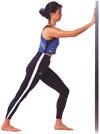Helpful Stretches Chicago, IL
Keep in mind:
Prior to any rigorous exercise you do not want to static stretch, research has shown that static stretching prior to exercise will leave muscles prone to damage. Instead warm-up prior to every exercise, dynamic stretches, than static stretches following your workouts. This allows the muscles to be warm which allows them to be much more elastic like and you'll thank me later.
- DO NOT stretch cold muscles they will become injury prone
- Ideal to do a dynamic stretch after warm-ups
- Good to stretch very lightly prior to doing any speed or up tempo work
- Ease slowly into each stretching motion
- DO NOT FORCE the movement - this may cause a reflexive contraction of the muscle causing a strain/tear
- Static stretches should be held for 5 deep breaths post workouts
Here are 12 static stretches for post workouts:
1. Supine Hamstring Stretch Keep your upper body relaxed.
- Maintain both legs straight, and pull one toward you.
- You might also try to bend the stretched leg holding it with your hands behind the knee then try to straighten it out as far as possible.
- You should feel the stretch higher up the hamstring.
2. Supine Glute Stretch
- Place your foot up on the wall then place the ankle of your front leg just below your knee.
- If you are a proper distance from the wall the knee of the wall leg will be bent to 90 degrees.
- As gravity gently brings your lower back towards the floor, you’ll feel a stretch in the muscles around the side of your buttocks.
- An excellent modification of this stretch is done seated.
- Assume the same position, but in a chair, then bring your belly button toward the knee of the crossed leg.
5. Soleus (lower calf) stretch
- Very similar to the Gastrocnemius stretch but you will stand closer to the wall and bend your knee, be sure to keep your foot flat on the floor.
- You should feel a stretch in your lower calf.
- Leaning in toward the wall will increase the level of the stretch; there should be little if any pressure on the other foot.
6. Iliotibial band stretch
- Place the foot closest to the wall around behind the other, with both feet flat on the ground.
- Keep both legs straight, and then lean your hips towards the wall.
- You should feel the stretch down the outside of your leg and up to your hip.
- This is a difficult stretch to do properly; it may take practice to do it well.
7. Iliopsoas (hip flexor) stretch
- Keep your hips squared to the front.
- Step forward with one leg try not to let your knee pass over the front of your foot.
- Be sure to keep your torso upright (if you lean forward it decreases the stretch achieved).
- Sink your hip toward to ground.
- For more advanced stretch reach your arm, on the same side of the leg you are stretching, up above your head.
10. Cross-leg glute stretch
- This is a much more advanced stretch than the gluteal stretch in #2.
- Start in a cross-legged position with your back upright.
- Your shins should be parallel to your body.
- Keeping a straight back, press your belly button forward with arms outstretched, (again AVOID rounding out your low back).
11. Downward-facing dog
- Keep your feet about hip-width apart and your hands about shoulder-width apart.
- Keep your legs straight, keep your hips high, and try to keep your heels on the ground (don’t worry if they don’t reach).
- DO NOT round out your low back, the bend should be entirely at your hips (maintaining your back in neutral).
- Press your palms and fingers flat into the ground; you should feel as though you’re trying to push the floor apart between your hands and feet.
12. Supine low back twist
- Start on your back with both legs straight.
- Hug your right knee in towards your chest, and bend your knee to 90 degrees.
- Then roll to your left side, so your right knee touches the floor, you should keep your right shoulder on the ground.
- Then extend your right arm towards the floor.
- Hold this position and relax into it with slow deep breathing.
- Then repeat on the opposite side.













